Symptom of Damage
- Yellowing of leaves from tip to downwards
- Plant stunted with reduced vigor
- Withering or complete drying of plant by sucking the plant sap.
- White or pale yellow eggs inside leaf sheaths or midribs.
- Pale green adults feeding on upper parts of the crop.
Nature of Damage
- Both nymphs and adults suck the plant sap from the leaf and leaf sheath.
- Mild infestation reduces the vigour of the plant and the number of reproductive tillers.
- Plants are predisposed to fungal and bacterial infection through feeding and ovipositional punctures.
- Tungro is transmitted during short feeding period.
|
 |
 |
| Orange yellowing of leaves |
Stunted plant with reduced vigor |
 |
 |
| Nymphs feed on plant by sucking the sap |
Adults feed on plant by sucking the sap
|
. |
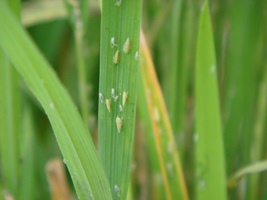 |
Identification of pest
Scientific Name - Cnaphalocrocis medinalis
- Egg : Greenish transparent eggs are deposited in the midrib of leaf blade or sheath of rice or green grass. They are laid in batches of 10 to 15 arranged in a single row.
- Nymph :
The nymphs are soft bodied, yellow white in colour. Gradually the colour changes to green with five nymphal instars and become adults in 18-20 days.
- Adult : Adults are 3-5 mm long, bright green with variable black markings, wedge shaped with a characteristic diagonal movement. Male insect has a black spot in middle of the forewings that is absent in females. The insect is active during July to September
|
| Nymph |
Nymph |
 |
 |
| Adult |
Adult |
Management Strategies
- The most effective means of GLH management is to use GLH-resistant and tungro-resistant varieties like IR 50, IR 54, IR 64, CR 1009, PY 3, Co 46 and white ponni .
- Apply neem cake @ 12.5 kg/20 cent nursery as basal dose.
- Transplanting older seedlings (>3 weeks) reduces viral disease susceptibility transmitted by leafhoppers.
- Good weed control in the field and on the bunds removes the preferred grassy hosts of Green leaf hopper and promotes crop vigor.
- Crop rotation with a non-rice crop during the dry season decreases alternate hosts for diseases.
- Upland rice intercropped with soybean reduces the incidence of leafhoppers on rice compared to rice alone
|
|
|
 |
 |
| Apply neem cake to nursery |
Use resistant variety - CR 1009 |
 |
 |
| Use resistant varieties - White ponni |
Weed control on field and bunds |
|
| Top |
| Brown plant leafhopper (Nilaparvata lugens) |
 |
 |
Symptom of Damage
- Hopperburn or yellowing, browning and drying of plant. Circular patches of drying and lodging of matured plant.
- Nymphs and adults congregate at the base of the plant above the water level.
- Affected plant dries up and gives a scorched appearance called “hopper burn”. It is vector of grassy stunt, ragged stunt and wilted stunt diseases.
Hopper burn caused by the plant hoppers is distinguished from other hopper burn symptom by the presence of visible sooty molds at the bases of the rice plant. Virus infected plants may also be found.
Nature of Damage
- Both the nymphs and adults remain at the ground level and suck the plant sap.
- It is a typical vascular feeder primarily sucking phloem sap leading to hopper burn. At early infestation, circular yellow patches appear which soon turn brownish due to the drying up of the plants.
- The patches of infestation then may spread out and cover the entire field. The grain setting is also affected to a great extent. During sustained feeding, it excretes a large amount of honeydew.
|
| Circular dry patches in field |
Completely withered and desapped plant |
 |
 |
| Hopper burn symptom |
Presence of Brown plant hopper nymphs and adults |
|
|
Identification of pest
Scientific Name - Nilaparvata lugens
- Egg : Eggs are laid in a group of 2 to 12 in leaf sheath (near the plant base or in the ventral midribs of leaf blades). White, transparent, slender cylindrical and curved eggs are thrust in straight-line in two rows. (They are covered with a dome - shaped egg plug secreted by the female. Only the tips protrude from the plant surface).
- Nymph : Freshly hatched nymph is cottony white, 0.6 mm long and it turns purple-brown, 3.0 mm long in the fifth instar.
- Adult :
Adult hopper is 4.5-5.0 mm long and has a yellowish brown to dark brown body. The wings are sub hyaline with a dull yellowish tint. It has two characteristic wing morphs: macropterous (long winged) and brachypterous (short winged).
|
 |
 |
| Egg |
Nymph |
 |
 |
| Adult |
Adult |
 |
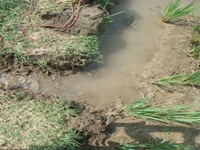 |
Management Strategies
- Draining the rice field for 3-4 days is recommended during the early stage of infestation.
- Nitrogen application can be split to reduce Brown plant hopper buildup.
- Synchronous planting within 3 weeks of staggering and maintaining a free-rice period could also decrease the build-up of Brown plant hopper.
- There are varieties released by IRRI, which contain genes for Brown plant hopper resistance, like IR26, IR64, IR36, IR56, and IR72.
- Use resistant varieties like PY 3, CO 42, ADT 35, ADT 37, PTB 33 and PTB 21, Aruna, Kanaka, Karthika, Krishnaveni, Makon, Abhey, Asha, Divya.
- Avoid close planting and provide 30 cm rogue spacing at every 2.5 to 3.0 m to reduce the pest incidence.
|
| Avoid excess use of nitrogen |
Intermittent draining of water |
 |
 |
| Provide rogue spacing of 30 cm |
Use resistant variety IR 36 |
|
| Top |
| White backed plant hopper |
Symptom of Damage
- Suck the sap and cause stunted growth.
- ‘Hopper burn’ is caused in irregular patches.
Nature of Damage
- White backed plant hopper is more abundant during the early stage of the growth of rice crop, especially in nurseries. Rice is more sensitive to attack at the tillering phase than at the boot and heading stages.
- Damage is caused through feeding and oviposition. Gravid females cause ovipositional punctures in leaf sheaths.
- Both nymphs and adults suck phloem sap causing reduced vigour, stunting, yellowing of leaves and delayed tillering and grain formation.
- Rice crop fails to produce complete grains [seedless glumes] and this condition is known as red disease.
- Feeding puncture and lacerations caused by ovipositor predispose the plants to pathogenic organisms and honeydew excretion encourages the growth of sooty mould.
|
 |
 |
| Circular dry patches in field |
Completely desapped plant |
 |
 |
| Hopper burn symptom |
Presence of nymphs and adults |
| |
|
 |
 |
Identification of pest
Scientific Name - Sogatella furcifera
- Egg : Cylindrical eggs are laid in groups when the rice plant is small but in the upper part of the rice plant when the plant is large.
- Nymph : White to a strongly mottled dark grey or black and white in colour and 0.6 mm size when young. Fifth instar nymph with a narrow head and white or creamy white body. Dorsal surface of the thorax and abdomen marked with various amounts of grey and white markings.
- Adult : The adult hopper is 3.5 - 4.0 mm long. The forewings are uniformly hyaline with dark veins. There is a prominent white band between the junctures of the wings. Macropterous males and females and brachypterous females are commonly found in the field.
|
| Nymph |
Adult |
 |
|
| Nymph and Adult |
|
Management Strategies
- Control irrigation by intermittent draining
- Synchronous planting within 3 weeks of staggering and maintaining a free-rice period could also decrease the build-up of Brown plant hopper.
- There are varieties released by IRRI, which contain genes for White backed plant hopper resistance, like
- IR26,
- IR64,
- IR36,
- IR56, and
- IR72.
- Avoid close planting and provide 30 cm rogue spacing at every 2.5 to 3.0 m to reduce the pest incidence.
|
 |
 |
| Intermittent draining of water |
Provide rogue spacing of 30 cm |
 |
|
| Use resistant variety IR 36 |
|
|
| Top |
| Leaf folder |
 |
 |
Symptom of Damage
- Leaves folded longitudinally and larvae remain inside.
- Larvae scrape the green tissues of the leaves and become white and dry.
- During severe infestation the whole field exhibits whitish scorched appearance.
Nature of Damage
- The leaves of the plant are seen folded, rolled and often webbed together with white patches on them indicating the areas fed by caterpillar.
- When such folded leaves are opened up, larvae can be seen.
|
| Leaves folded longitudinally |
Larva scraps green tissues of leaves |
 |
 |
| Whitish scorched appearance |
Presence of larva |
|
Identification of pest
Scientific Name - Cnaphalocrocis medinalis
- Egg : Flat, oval in shape and yellowish white in colour.
- Larva : Greenish translucent, prothoracic shield straight apically and rounded laterally.
- Pupa : Pupal period is 7 to 10 days.
- Adult : Moth is yellow brownish wings with many dark wavy lines in centre and dark band on margin of wings.
|
 |
 |
| Leaf folder larva |
Leaf folder adult |
| |
|
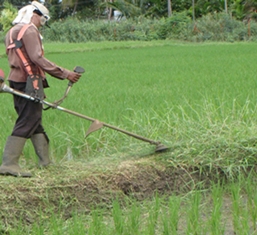 |
 |
Management Strategies
- Use resistant varieties like, Cauveri, Akashi, TKM 6, TKM 12, ADT 46,TPS 2, TPS 3, ADT 44, PY 4, Kairali,Ahalya,kunju kunju varna, kunju kunju priya, Reshmi (PTB 44), Neeraja(PTB 47) and Deepthi.
- Keep the bunds clean by trimming them
- Remove the grassy weeds.
- Clipping of the affected leaves.
- Use of rope to dislodge the leaf feeding larvae of leaf folders.
- Open up the leaf folds with the help of a thorny twig.
|
| Keep the bunds clean |
Use resistant varieties ADT 46 |
 |
|
| Use resistant varieties TPS3 |
|
| Stem borer |
|
Symptom of Damage
- Presence of brown coloured egg mass near the leaf tip.
- In vegetative stage larva enters the stem and feeds on the growing shoot and causes drying of the central shoot known as “dead heart”.
- In grown up plant whole ear heads become dried and yield chaffy grains called as “white ear”.
Nature of Damage
In the vegetative phase, the central shoot dies off turning yellow in colour (dead heart).
In the ear bearing stage, the ear head appears completely chaffy and white in colour (white ear head).
Both come out easily when pulled up and show indication of feeding injuries at the base.
|
 |
 |
| Dead heart |
Dried up central shoot |
 |
 |
| Bore hole |
White ear with chaffy grains |
 |
 |
Identification of pest
Scientific Name - Scirpophaga incertulas
- Egg : Eggs are creamy white, flattened, oval and laid in a mass which is covered with buff coloured hairs. They are laid mostly near the tip of the leaves. Egg period is 5-8 days.
- Larva : Pale yellow with dark brown head having prothoracic shield. Larval period is 28 to 30 days.
- Pupa : White silken cocoon. Pupation takes place inside the rice stem, straw or stubble. Pupal period is 8 to 10 days.
- Adult :
Female moth :
Has bright yellowish brown with a black spot at the centre of the fore wings and a tuft of yellow hairs at the anal region.
Male moth :
Smaller with pale yellow forewings without black spot.
|
| Egg |
Larva |
 |
|
| Adult |
|
Management Strategies
- Field should be necessarily be scouted during the vulnerable crop growth stages for early detection of dead hearts and white ear.
- Removal and proper disposal of stubbles will keep the borer population low in next crop.
- Grow resistant varieties like Ratna, TKM 6, IR 20 , IR 40, IR 56, ADT 47, ADT 48, ASD 20, IR 36, ADT 44, PY 4, ADT 46, Madhu, Kanchana, Swarnapraba, karthika, Deepthi and Tellahamsa.
- Clip the tip of the seedlings before transplanting to eliminate egg masses.
- Collect and destroy the egg masses.
- Avoid close planting and continuous water stagnation at early stages.
- Pull out and destroy the affected tillers.
- Harvest the crop up to the ground level and disturb the stubbles with plough immediately after the harvest to keep the borer population low in next crop.
|
 |
 |
| Disturb stubbles after harvest |
Harvest the Crop to Ground Level |
 |
 |
| Use Resistant Varieties - ADT 47 |
Use Resistant Varieties - IR 36 |
|
| Top |
| Thrips |
 |
 |
Symptom of Damage
- Laceration of the tender leaves and suck the plant sap
- Yellow (or) silvery streaks on the leaves of young seedlings.
- Terminal rolling and drying of leaves from tip to base.
- Damaged leaves roll inwards along the margins, feeding causes leaf drying resulting poor crop growth. The damage is severe under water stress conditions.
- It causes damage both in nursery and main field.
Nature of Damage :
Both the adults and nymphs lacerate the tender leaves and suck up the plant sap. As a result fine yellowish lines or silvery streaks are seen on the leaves. Later, the leaves curl longitudinally and begin to dry from the tip downwards In severe cases, the entire nursery may dry up and fail to produce seedling. Sometimes transplanted crop is also affected in the early stages. |
| Laceration of tender leaves |
Silvery streaks on the leaves |
| |
|
 |
 |
Infected leaves roll inwards
along the margins |
Terminal rolling and drying
of leaves |
Identification of pest
Scientific Name - Stenchaetothrips biformis
- Egg : Eggs are laid singly in the tissues of the tender leaves on the sides facing the stem. Eggs are hyaline and turn pale yellow as they mature. Eggs are laid in the slits of leaf blade tissue. The upper half of the egg is exposed.
- Nymph : Newly hatched nymphs are transparent but turn yellowish white after the first molt and possess darker legs, head and antennae. Neonate larvae feed on the soft tissues of unopened young leaves.
- Pupa : Pupation takes place inside the rolled leaves and appendages and wings are clearly visible.
- Adult : Adult is 1mm long, dark brown to black in colour with fringed wings. Male is smaller, more slender than female. It reproduces partheno-genetically since males are seldom seen in the population.
|
 |
 |
| Nymph |
Winged Nymph |
 |
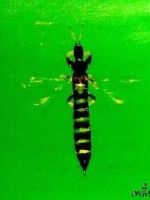 |
| Adult |
Adult |
 |
 |
Management Strategies
- Submerge infected crops intermittently for 1-2 days.
- Drag a wet cloth on the seedlings.
- Flooding to submerge the infested field for 2 days as a cultural control practice is very effective against the rice thrips.
- There are identified cultivars with known resistance to the rice thrips.
- Use resistant/tolerant varieties.
|
| Flood the infected nursery |
Submerge infected field |
|
| Top |
| Ear head bug |
Symptom of Damage
- Sucking the sap from individual grains, which are in milky stage.
- Due to de-sapping, grains show brownish discoloured patches on the husk.
- Individual grains become chaffy and erect panicles.
- Black spots on the grains at the site of feeding puncture.
- In the case of heavy infestation, the whole ear head may become devoid of mature grains.
- Buggy odour in rice field during milky stage.
- Obnoxious odour eminates on disturbing the bugs.
Nature of Damage
Both adults and nymphs do the damage. The nymphs start feeding 3 to 4 hours after hatching. They feed on the leaf sap near the tip / on milky sap in developing spikelets at milky stage. Sucking of the milky sap causes ill-filled / partial filled and chaffy grains. They omit bad smell hence they are called Gundhi bugs. Serious infestation can reduce the yield by 50%. The straw gives off-flavour that is unattractive to the cattle. |
 |
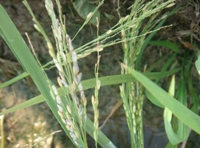 |
Feeding injuries and
spots on grains |
Chaffy and erect panicles |
 |
 |
Infected leaves roll inwards
along the margins |
Terminal rolling and drying
of leaves |
| |
|
 |
 |
Identification of pest
Scientific Name - Leptocorisa acuta
- Egg : Eggs are circular, brownish seed like, 2 mm long, laid in clusters in two rows along the midrid on the upper surface of the leaf-blade.
- Nymph : First instar is small, 2 mm long, pale green in colour, which grows to deep green through different instars.
- Adult :
Adults are greenish yellow, long and slender, above ½ inch in length with a characteristic buggy odour.
|
| Egg |
Nymph |
 |
 |
| Adult |
Adult |
Management Strategies
- Strict vigilance is necessary at milky stage.
- Cultural control measures include the removal of alternate hosts such as grasses on bunds, early planting, and the use of late-maturing cultivars.
- Keep the field and bunds free of weeds and grasses.
- Netting and handpicking the bugs reduce their numbers.
- Putting attractants such as arasan or anything with an odor like dead snails or rats can easily capture rice bugs in the field.
- Coarse-grain and bearded cultivars may be resistant to the rice bugs.
|
 |
 |
| Hand picking of bugs |
Keep the field weed free |
 |
 |
| Use coarse grain variety - TMK 9 |
Use hand nets to pick the bugs |
|
| Top |
| Army worm |
 |
 |
Symptom of Damage
- Larvae cut the seedlings in large scale.
- Severe infestation - cattle grazing appearance to the field.
- They feed gregariously and march from field to field.
Nature of Damage
- Caterpillars march in large numbers in the evening hours and feed on the leaves of paddy seedlings till the morning and hide during daytime.
- They feed gregariously and after feeding the plants in one field march onto the next field. Under severe infestation crop gives the grazed appearance.
- Attacked plants are reduced to stumps. Nurseries situated in ill-drained marshy areas attacked earlier than dry ground. Damage is severe during July to September.
|
| Irregular feeding by caterpillar |
Leaves completely eaten away
by the caterpillars |
 |
 |
| Presence of larva |
Defoliated leaves |
|
Identification of pest
Scientific Name - Spodoptera mauritia
- Egg : Eggs are spherical and creamy in colour, which are laid in a group covered over with grey hairs.
- Larva : The caterpillars are light green with yellowish white lateral and dorsal stripes in the early stage and later become dark brown or grayish green in colour with a crescent (Semi-circular) shaped black spot on the side of each segment.
- Pupa :
They pupate inside the soil in earthen cocoons. Pupa is dark brown and measures 16-17mm long.
- Adult : The adult moth is medium sized, stout built dark brown with a conspicuous triangular black spot on the forewings. Hind wings are brownish white with thin black margins.
|
 |
 |
| Adult |
Larva |
| |
|
| |
|
| |
|
| |
|
| |
|
| |
|
 |
 |
Management Strategies
- Drain the water in the field.
- Flooding the nursery makes the hiding larvae to come to the surface and thus they are picked by birds.
- Allow ducks into the field.
|
Flood the nursery to expose
hiding larva |
Trimming of bunds to remove
alternate hosts |
|
| Top |
| Gall midge |
Symptom of Damage
- Presence of silver shoot or “onion leaf” in the place of central leaf is the prominent symptom.
- The symptom appears from the nursery to the flowering stage.
- Formation of a hollow cavity or tubular gall at the base of the infested tiller.
- Infected tillers inhibit growth of leaves and fails to produce panicles.
- Stunted plants and deformed, wilted, and rolled leaf
|
 |
 |
| Presence of onion or silver shoot |
Presence of tubular galls |
 |
 |
Identification of pest
Scientific Name - Orseolia oryzae
- Egg : Reddish, elongate, tubular eggs just near the ligule of the leaf blade
- Larva : Maggot is pale to red colour feeds inside the gall.
- Pupa : Pupates at the base of the gall and moves to tip of the gall.
- Adult : Adult is orange coloured mosquito like fly
|
| Egg |
Adult |
| |
|
Management Strategies
- Use resistant varieties like MDU 3, Shakthi, Vikram, Sureka, Pavithra, Panchami and Uma.
- Avoid late transplantation during the first crop season.
Harvest the crop and plough immediately.
- Use optimum seed rate of 100 kg/ha.
- Setup light trap and monitor the adult flies.
|
 |
 |
| Infra red light traps |
Use resistant variety - MDU 3 |
| |
|
|
| Top |
| Case worm |
 |
 |
Symptom of Damage
- Full grown caterpillars found in tubular cases made out of paddy leaf, attached hanging to the leaf blade. The caterpillar skeletonises the leaves in ladder like manner. Pupation in the cases, which are attached to the lower side of the basal leaves.
- Caterpillars feed on green tissues of the leaves and leave become whitish papery
- Tubular cases around the tillers by cutting the apical portion of leaves
- Floating of tubular cases on the water
- Leaves cut at right angles as if with a pair of scissors.
|
| Floating of tubular cases around the tillers |
Papery white leaves |
| |
|
Identification of pest
Scientific Name - Orseolia oryzae
- Egg : Eggs are light yellow, disc like, smooth and irregular in shape. They are laid on the underside of the leaves floating on the water.
- Larva :
They hatch into green caterpillars with orange brownish head. Each caterpillar lives inside a tubular case and hang down the leaves. Full-grown caterpillars measure upto 15 mm length.
- Pupa :
It pupates inside the leaf case. Fresh pupae are milky white, which gradually turn to light yellow.
- Adult : The adult is a small delicate moth having white wings speckled with pale brown wavy markings. Females are larger than males. Egg lying takes place in the night.
|
 |
 |
| Larva |
Adult |
 |
|
| Moth |
|
 |
Management Strategies
- A rope may be passed over the young crop for dislodging the larval cases from the tillers and then the water may be drained for eliminating them or pass the rope from one end to other end to dislodge the eggs.
- Use of correct fertilizer application, wider spacing and early planting.
|
| Pass the rope to dislodge
casetubes and eggs |
|
| Top |
| Rice Skipper |
Symptom of Damage
- Removal of leaf tissues and veins and sometimes leaving only the midrib
- Rolling down of leaf tip or folding two edges of the same leaf or two adjacent leaves and tying them with silken threads to make a protective chamber.
- It occurs in the nursery and planted crop.
Nature of Damage
- The caterpillar folds the leaves and feeds from inside.
- It feeds on the parenchyma leaf and gets reduced to skeleton
|
 |
 |
Floating of tubular cases around
the tillers |
Papery white leaves |
| |
|
 |
 |
Identification of pest
Scientific Name - Orseolia oryzae
- Egg : Eggs are laid on the leaves.
- Larva : The caterpillar is elongate, yellowish green with four white dorsal stripes, smooth with a constructed neck and red ‘V’ mark on the head, which is distinct.
- Pupa : Pale green pupa has white longitudinal lines on it and is attached to the leaf blade by a silk girdle.
- Adult : The adult is a dark brown skipper butterfly with two white spots on the wings.
|
| Larva |
Adult |
| |
|
| |
|
Management Strategies
- Flood the nursery to expose the hiding larvae to the surface and thus birds pick them up.
- Allow the ducks into the field to feed on the larvae.
|
 |
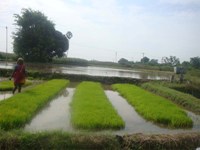 |
| Allow ducks into the field |
Flood the nursery |
|
| Top |
| Grass hopper |
Symptom of Damage
- Irregular feeding on seedlings and leaf blade
- Large portions of leaf edges consumed.
- Cutting of stem at panicle stage.
- Completely defoliate the plants leaving only the mid ribs.
- Presence of nymphs and adults feeding on paddy foliage.
|
 |
 |
| Irregular feeding on leaves |
Leaves are defoliated from the margin or tip irregularly |
 |
 |
Identification of pest
Scientific Name - Pelopidas mathias
- Egg : The eggs are laid in batches of 30-40, hatch only in June to July on receipt of the monsoon rains. Eggs are yellowish and covered with gummy substrate that hardens into a waterproof coating.
- Nymph : The nymphs feed on the grasses and paddy crop.
- Adult : They grow into adults by August to September. Hieroglyphus banian (Large Grasshopper) measures about 1 ½ inch long. There are three transverse dark lines on the prothorax, which is helpful for identifying the pest. Oxya nitidula (Small grasshopper) is about one inch long and has a longitudinal brown streak on either side of the thorax.
|
| Grass hopper |
Grass hopper |
| |
|
| |
|
| |
|
| |
|
Management Strategies
- Flooding the stubbles, trimming the bunds, sweeping along the bunds and adult grass hoppers can be picked directly from the foliage at night because they are sluggish.
- Expose the eggs to be picked up by birds after ploughing and trim the bunds.
|
 |
 |
| Allow ducks into the field |
Flood the nursery |
|
| Top |
| Whorl Maggot |
 |
 |
Symptom of Damage
- Maggot feeds on the tender tissue inside the whorl.
- Yellowish white longitudinal marginal blotching with hole.
Drooping of young leaves near the tip.
- The maggots attack the leaf blades and the initial damage is characterized by the presence of narrow stripes of whitish areas in the blade margins.
- White or transparent patches.
- Presence of feeding lesions in the lines and the infested plants become stunted.
Damaged leaves easily break from the wind
|
Yellowish white marginal
blotching of leaves |
Presence of maggot |
| |
|
| |
|
| |
|
Identification of pest
Scientific Name - Hydrellia sasakii
- Egg : White, cigar shaped egg laid singly on either side of the leaves.
- Grub : Newly hatched larva is transparent to very light cream in colour but later become yellow. The larvae move down the leaf into the whorl. Damage can be seen as pinholes in the leaves and white and yellowish lesions on the leaf edge.
- Pupa : Pupation takes place in between the leaf sheath where the pupa is loosely attached the stem. The puparium is light to dark brown ovoid and sub-cylindrical in shape.
- Adult : Adult dark grey flies, 1.8-2.3 mm in size.
|
 |
 |
| Egg |
Larva |
 |
 |
| Whorl maggot |
Whorl maggot adult |
 |
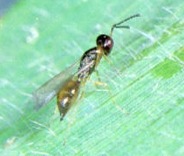 |
Management Strategies
- Remove the alternate hosts and adjust the time of planting (early).
- The eggs are parasitized by Opius sp., Tetrastichus sp., and Trichogramma sp., and preyed upon by Dolichopus sp., Medetera sp., and Syntormon sp.
- The adults are hosts to spiders Lycosa pseudoannulata, Neoscona theisi, Ochthera brevitibialis, and Oxyopes javanus.
- Small wasps parasitized the eggs and the maggots. Dolicopodid flies prey on the eggs and ephydrid flies and spiders feed on the adults.
|
| Removal of alternate hosts |
Wasps parasitize maggots |
| |
|
| |
|
|
| Top |
| Rice Hispa |
Symptom of Damage
- The mining of the grubs will be clearly seen on the leaves.
- Scraping of the upper surface of the leaf blade leaving only the lower epidermis as white streaks parallel to the midrib.
- Tunneling of larvae through leaf tissue causes irregular translucent white patches that are parallel to the leaf veins.
- Damaged leaves wither off.
- Rice field appears burnt when severely infested.
Nature of Damage
- The grub mines into the leaf blade and feed on the green tissue between the veins.
- Adults also feed in the green tissue; they scrape green matter of the tender leaves.
- Generally the plants are affected in the young stage.
|
 |
 |
| Mining of leaves by grubs |
Presence of beetles with scrapping on leaves |
| |
|
| |
|
| |
|
| |
|
| |
|
| |
|
| |
|
| |
|
| |
|
| |
|
| |
|
| |
|
 |
 |
Identification of pest
Scientific Name - Dicladispa armigera
- Egg : Eggs are laid inside minute slits on the tender leaves generally toward the tip.
- Grub : The grub is whitish yellow and flattened. It feed inside the leaf tissue by mining. It pupates inside.
- Adult : The adult beetle is somewhat square shaped about 1/6 to 1/8” in length and width Dark blue or blackish in colour with spines all over the body.
|
| Larva |
Rice Hispa |
 |
 |
| Rice Hispa |
Rice Hispa adult |
Management Strategies
- Close plant spacing results in greater leaf densities that can tolerate higher hispa numbers.
- Leaf tip containing blotch mines should be destroyed.
- Manual collection and killing of beetles – hand nets.
- To prevent egg laying of the pests, the shoot tips can be cut.
- Clipping and burying shoots in the mud can reduce grub populations by 75 - 92%.
- Reduviid bug eats upon the adults.
|
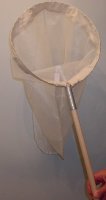 |
 |
Collect beetle using hand net
and destroy |
Destroy leaf tips containing
blotch mines |
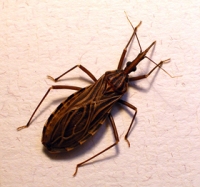 |
|
| Reduviid bug feed on adult hispa |
|
| |
|
| Top |
| Yellow hairy caterpillar |
|
Symptom of Damage
- Caterpillar causes defoliation.
- Larva feeds on leaf blades of rice.
- Leaves are defoliated from the margin or tip irregularly.
|
 |
 |
| Mining of leaves by grubs |
Presence of beetles with
scrapping on leaves |
 |
 |
Identification of pest
Scientific Name - Psalis Pennatula
- Egg : Laid in batches on the leaves covered with yellow hairs.
- Larva : The Caterpillar is yellow with red stripes and an orange head. Tuft of hairs are found all over, of which two in the anterior region and one in the posterior region are prominent.
- Pupa : Pupation is in yellowish cocoon of hairs on the leaves.
- Adult : Moth is light yellow with bipectinate antenna.
|
| Larva |
Rice Hispa |
| |
|
| |
|
Management Strategies
- The eggs are parasitized by trichogrammatid wasps.
- Chalcid wasp and two species of tachinid flies parasitize the larvae and a vespid wasp preys on the larvae.
- Expose the eggs to be picked up by birds after ploughing and trim the bunds.
- Meadow grasshoppers, ants, birds and toads feed on the caterpillar.
|
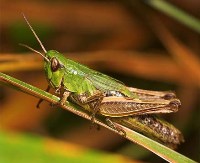 |
 |
| Meadow grasshoppers |
Trichogrammatid wasps |
| |
|
|
| Top |
| Rice horned caterpillar |
 |
 |
Symptom of Damage
- Larva feeds on leaf blades of rice.
- Leaves are defoliated from the margin or tip irregularly.
|
| Mining of leaves by grubs |
Presence of beetles
with scrapping on leaves |
Identification of pest
Scientific Name - Melanitis leda ismene
- Egg : White, round laid singly on the paddy leaves.
- Larva : Green with roughened skin flattened dorsally and has a dark brown head with a pair of red horn like processed and two yellow processes in the anal end. It feeds on the leaves.
- Pupa : Dark green chrysalis hangs from the leaf and is attached to the leaf blade by its anal extremity.
- Adult : The butterfly is dark brown with large wings having a few black and yellow eye-like markings one on each of the forewings and six ocellar spots on hind wings.
|
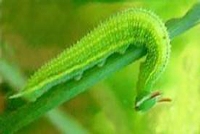 |
 |
| Rice horned caterpillar |
Rice horned caterpillar |
 |
|
| Rice horned caterpillar adult |
|
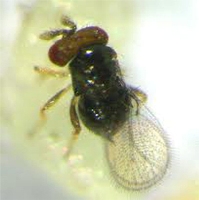 |
 |
Management Strategies
- Expose the eggs to be picked up by birds after ploughing and trim the bunds.
- Bio-control agents such as Cacallus spp., Barycomus spp. and Seelio spp., which are egg parasites should be encouraged.
- Release Trichogramma japonicum (egg parasitoid) on 30 and 37 DAT (twice) and T. chilonis on 37, 44 and 51 DAT (thrice) followed by three sprays of Monocrotophos 1000 ml/ha on 58, 65 and 72 DAT also reduce the pest.
- The eggs are parasitized by trichogrammatid wasps.
- Chalcid wasp and two species of tachinid flies parasitize the larvae and a vespid wasp preys on the larvae.
|
| Trichogramma japonicum |
Flood the nursery to expose
hiding larvae |
| |
|
| |
|
| |
|
| |
|
| |
|
| |
|
|
| Top |
| Black bug |
Symptom of Damage
- Presence of bugs at the base of the stem just above the water level.
- Plants stunted with reduced number of tillers; leaves turn reddish brown and dry.
- Stunting of plant with chlorotic lesions on leaves.
- Stunted panicles, no panicles, or incompletely exerted panicles, and unfilled spikelets or whiteheads at booting.
Nature of Damage
- Both nymphs and adult bugs remain and feed the plant sap on the base of the plants causing stunting of plants.
- Leaves turn reddish brown and grains do not develop.
- Bugs feed on the panicles in milky stage result in brown spot or empty grains in the panicles.
- Heavy bug infestation may cause death to the plants and whole field appears burned called bug burn similar to hopper burn.
|
 |
 |
Presence of black bugs
at the base of the stem |
Chlorotic lesions on leaves |
| |
|
| |
|
| |
|
| |
|
| |
|
| |
|
| |
|
| |
|
| |
|
| |
|
 |
 |
Identification of pest
Scientific Name - Scotinophora lurida
- Egg :
Eggs are cylindrical, greenish and laid in small groups of ten in two rows on the leaves.
- Nymph :
Young nymph is brown with yellowish green abdomen and a few black spots.
- Adult :
Adults are flat, 7-9 mm long, brownish black bugs with a prominent scutellum and pronotum having a spine on
either side. It is active on the cloudy days and during night. Adults or late nymphal stage aestivate in cracks in bunds.
|
| Black bug Adult |
Black bug Adult |
| |
|
| |
|
| |
|
| |
|
Management Strategies
- 10% damage at tillering stage or 5 bugs / hill.
- Maintain a clean field by removing the weeds and drying the rice field during ploughing.
- Rice varieties of the same maturity date may be planted to break the insect’s cycle.
- Direct-seeded rice crops tend to have less tillers in one planting point and thus discourage population growth.
- Flooding the fields can also cause higher egg mortality.
- Set up light trap during the full moon period to attract large number of bugs and kill.
- Conserve the predators viz Spiders, coccinellids and wasps to check the pest.
- Ducks can be allowed in the field to pick up the bugs.
- Spray Neem seed kernal extract 5% for effective control of black bug
|
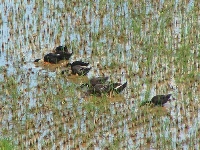 |
 |
| Allow ducks to pick the bug |
Conserve predator - Spider |
 |
 |
| Set up light traps |
Spray Neem Seed Kernal Extract |
|
| Top |
| Mealy Bug |
 |
 |
Symptom of Damage
- The damage is by sucking of the plant sap.
- An infested field shows isolated patches of stunted and sickly looking plants.
- The seedlings in the dry nursery are badly affected.
- Large number of insects remains in leaf sheath and suck the sap.
- Presence of white waxy fluff in leaf sheaths.
- Called as Soorai disease or Chakdhora or Damaged spots.
Nature of Damage
- Large numbers of these insects’ remains inside the leaf sheaths and suck up the plant sap.
- The affected tillers remain stunted with yellowish curled leaves.
- When the attack is severe, it inhibits panicle emergence.
- In severe cases, yield may be reduced even up to 50%.
|
| White soft bodied nymphs and adults remains inside the leaf sheath |
Desapped leaves |
| |
|
| |
|
| |
|
| |
|
Identification of pest
Scientific Name - Bravennia rohi
- Egg : The female lays numerous yellowish white eggs/simply deposits nymphs in outer leaf sheaths.
- Nymph : The newly hatched nymphs crowded within the waxy threads for 6-10 h before they disperse to various parts of the same plant. The pale yellowish nymph is active and crawls about the plant for a while and settled itself on the plant / stem and turns dark yellow after a day. Body gets covered with waxy material on second day.
- Adult : Nymphs and adults being wingless look alike. Wingless insect covered with filamentous materials. Female are reddish, oval, soft-bodied living in colonies inside the leaf sheath. Males are small, slender, pale – yellow, having single pair of wings and a style like process at the end of the abdomen but lack mouthparts.
|
 |
 |
| Mealy bug |
Mealy bug |
 |
|
| Mealy bug |
|
 |
 |
Management Strategies
- Remove the grasses from the bunds and trim the bunds.
- Remove and destroy the affected plants.
- Conserve the natural enemies like Scymnus sp.,Anatrichus pygmaeus, and Mepachymerus ensifer.
|
| Natural enemy - Scymnus sp |
Removal of grasses on bunds |
|
| Top |
| Root Grub |
Symptom of Damage
- They feed on roots.
- Yellowing and gradual wilting of entire plants.
- Stunted plants.
- Root loss.
|
 |
 |
| Grub damage |
Grub damage |
 |
 |
Identification of pest
Scientific Name - Leucopholis irrorata
- Egg : The eggs are pearly white and elongated or ovoid in shape.
- Grub :
The grub is creamy white and has a pair of sclerotized mandibles. Three pairs of prominent legs are visible on the thoracic area and its body is curled in a C-shaped position.
- Pupa : The pupa is dark brown.
- Adult :
The adult beetle is black or dark brown in color. Its pronotum is not margined except for its lateral edges. The male has a longer antennal club than the female adult. While the female has a broader tibial spur with a rounded end, the male has a slender and pointed tibial spur.
|
| Root grub larva |
Root grub |
 |
|
| Root grub adult |
|
Management Strategies
- Scoliid wasps parasitize the larvae.
- Carabid beetles, birds, toads, bats, and storks also eat the larvae and adults.
- The larvae are also infected by fungal pathogens.
|
 |
.jpg) |
| |
Carabid beetle |
Scoliid wasps |
|
| Top |
| Ants |
 |
|
Symptom of Damage
- Mainly occur in upland rice.
- Missing rice seeds
- No plants or missing plants.
- Loss of plant stand.
- Patchy distribution of damage in the field
|
| Ant damage |
|
Identification of pest
Scientific Name - Solenopsis geminata
- Egg : The queen ant usually lays 75 to 125 eggs in a cluster.
- Pupa
: Pupa is whitish in color and they develop in the nests.
- Adult : Adult ants have reddish brown body with brown head.
They have robust mandibles and mandibular teeth.
|
 |
 |
| Ant |
Ant |
 |
|
Management Strategies
- Increasing the seeding rate helps to compensate for losses caused by ants.
|
| Increase seed rate |
|
|
| Top |
|
| Cricket |
Symptom of Damage
- Irregular to longitudinal exit holes
- Cutting of central portions of the leaf blades leaving only the midrib
- Dead heart.
|
 |
 |
| Cricket damage |
Cricket feeding damage |
 |
 |
Identification of pest
Scientific Name - Euscyrtus concinnus
- Egg : Individual eggs are elongate-ovoid. Newly laid eggs are whitish and turn orange with age.
- Nymph : The nymph has the same color as the adult. It is a smaller version of the adult except for its wing pads. It has a pair of brown to black spots along its abdomen.
- Adult : The adult gryllid is pale brown. It measures 1.0 to 1.8 cm long. It has long antennae and legs. The female has a long and spear-shaped ovipositor. The female is longer in size than the male gryllid.
|
| Cricket |
Long horned cricket |
 |
|
| Long horned cricket |
|
|
Management Strategies
- Maintaining standing water in the field prevents crickets from field by tunneling into the soil and damaging the crop.
- Sphecid species such as Liris aurulenta, Motes manilae, Motes subtessellatus and Motes loboriosus parasitize field crickets.
|
 |
|
| Liris aurulenta |
|
|
| Top |
| Mole Cricket |
Symptom of Damage
- Loss of plant stand
- Seedlings cut at the base.
- Poor seedling growth.
- Seedling death.
- Missing plants.
- Root damages.
|
 |
 |
| Mole Cricket damage |
Mole Cricket feeding damage |
| |
|
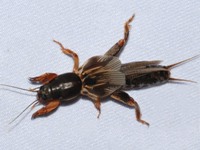 |
 |
Identification of pest
Scientific Name - Gryllotalpa orientalis
- Egg : Eggs are oblong to oval and gray with a shiny surface.They are 2.6 mm long. The eggs are deposited in a hole constructed by the adult female.
- Nymph : Neonate nymph has a white and bluish prothorax and legs. With age, it turns gray to black with white markings. The last nymphal stage is similar to the adult except for its short wing pads.
- Adult : The adult mole cricket is brownish and very plump. It measures 25-40 mm long. It has short antennae and its folded wings do not cover the entire length of the abdomen. The enlarged front legs, which are modified for digging, have strong teeth-like structures.
|
| |
|
 |
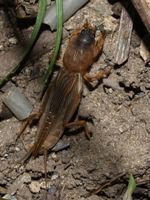 |
Management Strategies
- Cultural control includes maintaining standing water, which can help to remove the eggs on the soil.
- The eggs can also be eliminated using bund shaving and plastering of fresh wet soil.
- Levelling the field provides better water control.
- Construction of a raised nursery should be avoided to reduce feeding damage on seedlings.
- For natural biological control, a sphecid wasp, carabid beetle, nematodes, and a fungus are recorded as important natural enemies of the mole cricket.
- Mole crickets eat each other when they are together because of their cannibalistic behavior.
|
 |
 |
| Maintain Standing water |
Sphecid wasp |
| |
|
| |
|
| |
|
| |
|
| |
|
| |
|
| |
|
|
| Top |